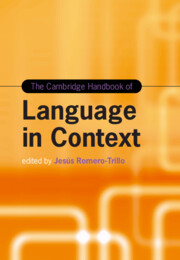265 results
5 - Context and Pragmatics
-
- Book:
- The Philosophy of Theoretical Linguistics
- Published online:
- 25 April 2024
- Print publication:
- 02 May 2024, pp 108-136
-
- Chapter
- Export citation
4 - The Science of Semantics
-
- Book:
- The Philosophy of Theoretical Linguistics
- Published online:
- 25 April 2024
- Print publication:
- 02 May 2024, pp 80-107
-
- Chapter
- Export citation
2 - Classifying health and wellbeing
- from Part 1 - Context
-
-
- Book:
- Health and Wellbeing in Childhood
- Published online:
- 08 March 2024
- Print publication:
- 04 March 2024, pp 18-32
-
- Chapter
- Export citation
Four - Divine Music in Context
-
- Book:
- Divine Music in Archaic and Classical Greek Art
- Published online:
- 01 February 2024
- Print publication:
- 29 February 2024, pp 158-199
-
- Chapter
- Export citation
Chapter 1 - Introduction
-
- Book:
- Realist Trials and Systematic Reviews
- Published online:
- 08 February 2024
- Print publication:
- 15 February 2024, pp 1-6
-
- Chapter
- Export citation
Chapter 9 - Using Evidence to Inform Intervention Scale-Up and Transfer
-
- Book:
- Realist Trials and Systematic Reviews
- Published online:
- 08 February 2024
- Print publication:
- 15 February 2024, pp 82-88
-
- Chapter
- Export citation
Chapter 4 - Building Realist Theory in Evaluations
-
- Book:
- Realist Trials and Systematic Reviews
- Published online:
- 08 February 2024
- Print publication:
- 15 February 2024, pp 26-36
-
- Chapter
- Export citation
2 - The Untenability of the Unembedded Homo economicus
- from Part I - The Failed Pathway and Exit Strategies
-
- Book:
- Identity, Capabilities, and Changing Economics
- Published online:
- 11 January 2024
- Print publication:
- 01 February 2024, pp 27-52
-
- Chapter
- Export citation
1 - Introduction
-
- Book:
- Academic Freedom and the Transnational Production of Knowledge
- Published online:
- 04 January 2024
- Print publication:
- 25 January 2024, pp 1-14
-
- Chapter
- Export citation
1 - Introduction and Overview
- from Part I - General Approach to the Diagnostic
-
-
- Book:
- Mozambique at a Fork in the Road
- Published online:
- 14 December 2023
- Print publication:
- 21 December 2023, pp 3-7
-
- Chapter
-
- You have access
- Open access
- HTML
- Export citation
12 - The Interplay of Linguistic, Conceptual, and Encyclopedic Knowledge in Meaning Construction and Comprehension
- from Part III - Pragmatic Approaches to Context
-
-
- Book:
- The Cambridge Handbook of Language in Context
- Published online:
- 30 November 2023
- Print publication:
- 14 December 2023, pp 268-288
-
- Chapter
- Export citation
5 - A Functional Approach to Context
- from Part II - Philosophical, Semantic, and Grammatical Approaches to Context
-
-
- Book:
- The Cambridge Handbook of Language in Context
- Published online:
- 30 November 2023
- Print publication:
- 14 December 2023, pp 116-139
-
- Chapter
- Export citation
15 - Health Policy
- from Part 2 - Contexts for Public Health Practice
-
-
- Book:
- Essential Public Health
- Published online:
- 01 December 2023
- Print publication:
- 14 December 2023, pp 290-302
-
- Chapter
- Export citation
Introduction to Part 2: What Do We Mean by Contexts in Public Health?
- from Part 2 - Contexts for Public Health Practice
-
-
- Book:
- Essential Public Health
- Published online:
- 01 December 2023
- Print publication:
- 14 December 2023, pp 204-208
-
- Chapter
- Export citation
21 - Social Media and Computer-Mediated Communication
- from Part V - Advances in Multimodal and Technological Context-Based Research
-
-
- Book:
- The Cambridge Handbook of Language in Context
- Published online:
- 30 November 2023
- Print publication:
- 14 December 2023, pp 455-476
-
- Chapter
- Export citation

The Cambridge Handbook of Language in Context
-
- Published online:
- 30 November 2023
- Print publication:
- 14 December 2023
8 - An Alternative Approach to ECHR Article 9 and the Related ECtHR Jurisprudence
- from Part III - reappraising the understanding of the right to freedom of thought, conscience and religion in echr article 9
-
- Book:
- Freedom of Religion or Belief in the European Convention on Human Rights
- Published online:
- 02 December 2023
- Print publication:
- 23 November 2023, pp 201-223
-
- Chapter
- Export citation
6 - Bringing in the Cognizer
-
- Book:
- Time, Metaphor, and Language
- Published online:
- 09 November 2023
- Print publication:
- 23 November 2023, pp 112-133
-
- Chapter
- Export citation
4 - Understanding Lexemes
-
- Book:
- Linguistic Knowledge and Language Use
- Published online:
- 19 October 2023
- Print publication:
- 02 November 2023, pp 117-180
-
- Chapter
- Export citation
Contextualising Counterfeits: Roman Coin Moulds in Britain and the Channel Islands
-
- Article
-
- You have access
- Open access
- HTML
- Export citation



